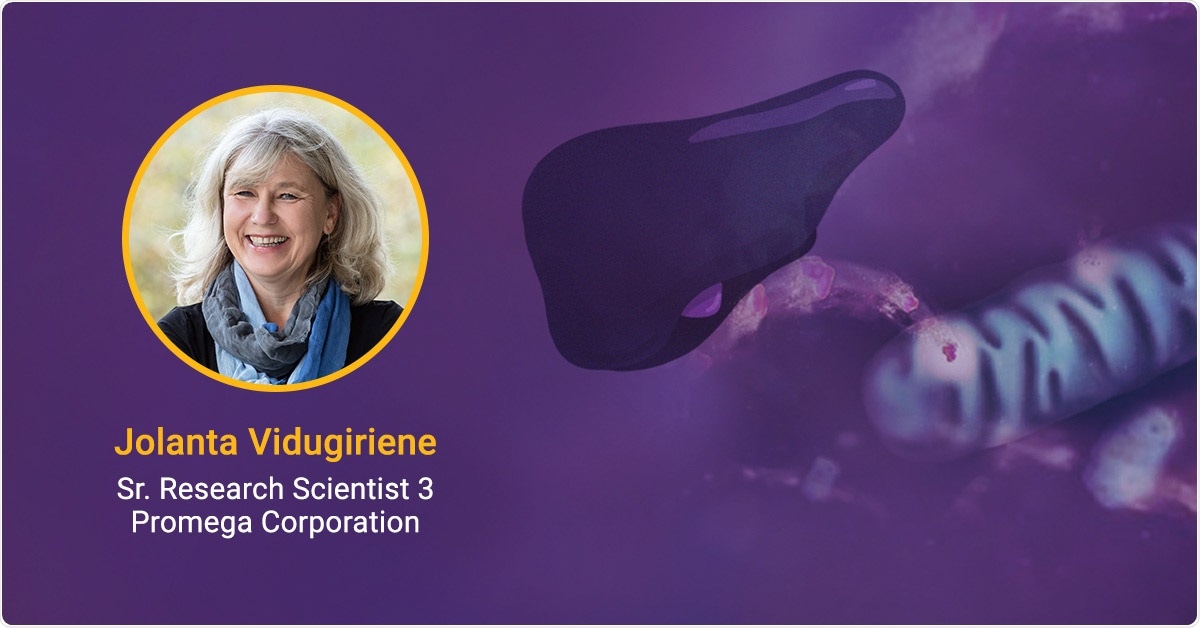In this interview, Jolanta Vidugiriene, a Senior Research Scientist at Promega Corporation, talks to News-Medical about tools for studying metabolism in NAFLD/NASH research.
What is nonalcoholic fatty liver disease (NAFLD)?
NAFLD is not a simple disease, it is an umbrella term for a range of liver conditions. The main defining characteristic of NAFLD is fat accumulation in the liver, called steatosis. In about 20% of people, steatosis is accompanied by inflammation, which is a more severe form of NAFLD called NASH (nonalcoholic steatohepatitis). NASH can progress to more advanced conditions like liver cirrhosis and liver failure. Most of the time, NAFLD is associated with underlying conditions – it is closely related to metabolic dysfunction, obesity, and type 2 diabetes. To better reflect the disease pathology, there has been a lot of discussion in the field recently to rename NAFLD to MAFLD, for metabolic associated fatty liver disease. Even though NAFLD has been studied for many years, the causes and progression of the disease are still not well understood. There are no FDA-approved diagnostic tools or treatments for it yet.
Why is it challenging to develop treatments for NAFLD?
We need a better understanding of the pathogenesis of NAFLD to develop good therapeutic interventions. NAFLD is a very complex, multifactorial disease that affects many metabolic pathways in different tissues throughout the body. Making things more complicated, cell metabolism pathways are highly intertwined. For example, obeticholic acid, an elite candidate in NAFLD/NASH clinical trials, is a potent and selective agonist of farnesoid X receptor (FXR). If we look at the biology of FXR, it affects both lipid and glucose metabolism through transcriptional regulation of multiple target genes. When FXR is activated, it affects multiple metabolic pathways to increase glucose storage, reduce fat storage, and convert cholesterol into bile acids. You can see how a single NAFLD/NASH drug can affect many aspects of cellular metabolism, which all need to be monitored to understand the effectiveness of the treatment.

Jolanta Vidugiriene, Senior Research Scientist, Promega Corporation
How can you measure metabolic pathways for NAFLD research?
Promega has been working for years to develop many assays that can measure cell metabolism pathways. The assays are simple and robust, while still achieving sensitive detection. We also have tools to measure oxidative stress and cell death, which are important in NAFLD/NASH disease progression.
Promega metabolite assays use an enzyme-coupled approach, which is a well-established, reliable method for metabolite detection. However, existing enzyme-coupled assays using fluorescence and absorbance detection suffer from poor sensitivity and narrow dynamic range. We wanted to develop assays that would overcome these challenges with a bioluminescent approach. So, we synthesized a highly specific reductase substrate which can be converted into luciferin in the presence of NADH or NADPH. The luciferin would then be used as a substrate for the luciferase enzyme to produce light. This is the core technology for our bioluminescent metabolite assays. By pairing with different dehydrogenases, we developed assays for detecting specific metabolites, such as glucose, lactate, glutamate, glutamine, glycogen, triglycerides, glycerol and cholesterol. The assays achieve a specific and robust readout for each metabolite with superior sensitivity and dynamic range.
How can Promega metabolite assays improve experimental workflows?
First of all, the assays kits are very flexible and amenable to researcher needs. They are widely compatible with many sample types, so researchers can utilize the same kits for all the samples in their workflows—from 2D adherent cell cultures to 3D organoids and tissue samples. We can measure extracellular metabolites from the media, or we can lyse the cells with a high concentration of detergent to immediately stop endogenous enzymes to measure intracellular metabolites. Regardless of sample type, preparation steps are easy—without centrifugation, deproteinization or organic extraction. Sample dilutions usually are not required, since the wide linear range of the assays can detect 1,000-fold changes in metabolite concentration. Finally, you can measure multiple parameters from a single sample; one cell or tissue lysate preparation can be used to detect multiple metabolites, so a single sample goes further to gain a complete understanding of cellular metabolism.
Can these assays be used for NAFLD/NASH drug discovery and development?
Yes, absolutely, they are very useful for drug discovery and high-throughput screening. The assays can be performed in 384-well plates, are automation-friendly, and have robust Z’ values suitable for screening. They can be used to both identify candidate compounds as well as test the implications of drug treatment on cellular metabolic pathways. For example, to assess the effects of FXR agonist treatment, we have assays for quantifying triglyceride accumulation, glucose uptake, and cholesterol levels.
Learn more about assays for NAFLD/NASH liver disease research at www.promega.com/LiverResearch